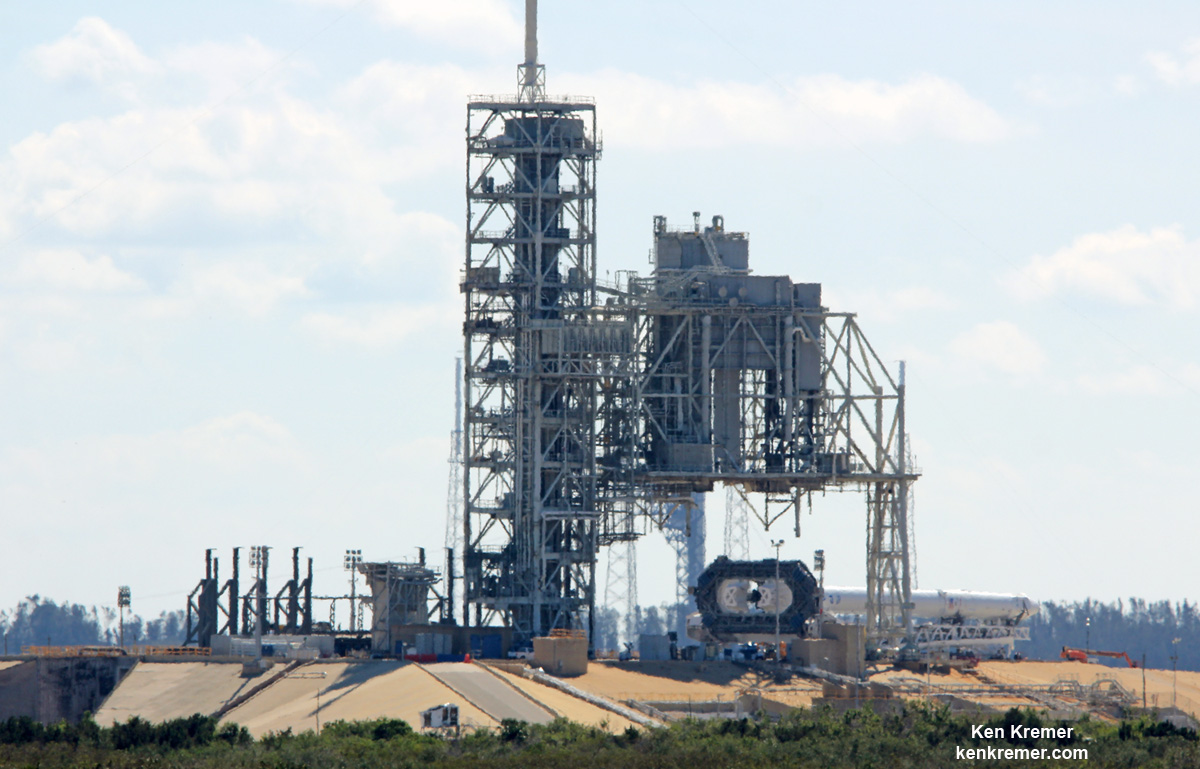
SpaceX Falcon 9 rocket goes vertical at night atop Launch Complex 39A at the Kennedy Space Center on 18 Feb 2017 as seen after midnight from the pad perimeter. This is the first rocket rolled out to launch from pad 39A since the retirement of NASA's Space Shuttles in July 2011. Liftoff slated for 18 Feb 2017. Credit: Ken Kremer/Kenkremer.com
KENNEDY SPACE CENTER, FL - Just hours before blastoff, the first ever SpaceX Falcon 9 set to soar to the space station from historic pad 39A at NASA's Kennedy Space Center (KSC), the rocket went vertical below delightfully dark skies on the Florida Space Coast.
Packed with over a thousand pounds of research experiments and science instruments probing the human body and our home planet from the heavens above, the Falcon 9 rocket is poised for liftoff at 10:01 a.m., Saturday morning, Feb. 18, from Launch Complex 39A (LC-39A) at KSC.
Everything is on track for Saturday's launch of the 229 foot tall SpaceX Falcon 9 on the NASA contracted SpaceX CRS-10 resupply mission for NASA to the million pound orbiting lab complex.
And the weather looks promising at this time.
At a meeting with reporters at pad 39A on Friday, Feb. 17, SpaceX President Gwynne Shotwell confirmed the success of the static fire test of the two stage rocket and all nine first stage Merlin 1D engines conducted on Sunday afternoon, Feb. 12 - minus the SpaceX Dragon cargo freighter payload.

SpaceX Falcon 9 rocket rests horizontal atop Launch Complex 39-A at the Kennedy Space Center on 16 Feb 2017 as seen from Launch Complex 39-B. This is the first rocket rolled out to launch from pad 39A since the retirement of NASA's Space Shuttles in July 2011. Liftoff slated for 18 Feb. Credit: Ken Kremer/Kenkremer.com
The successful test firing of the engines cleared the path to orbit for liftoff of Dragon on a critical cargo flight for NASA to deliver over two and a half tons of supplies and science on the CRS-10 resupply mission to the six person crew living and working aboard the International Space Station (ISS).
Shotwell then said technicians integrated with the unmanned Dragon CRS-10 cargo freighter with the Falcon 9 rocket.
The 22 story tall rocket rolled out of the SpaceX processing hangar at the perimeter fence and then up the incline to the top of pad 39A on Thursday morning using a dedicated transporter-erector, so ground crews could begin final preparations for the Saturday morning blastoff.
Thousands and thousands of spectators from across the globe, local residents, media and scientists and engineers and their families have flocked to the Florida Space Coast, filling area hotels to witness the historic maiden blastoff of a Falcon 9 from seaside pad 39A at KSC at 10:01 a.m. EST Saturday, Feb. 18.
SpaceX will also attempt to achieve a secondary mission goal of landing the 156 foot tall first stage of the Falcon 9 rocket on land at Cape Canaveral Air Force Station's Landing Zone 1, located a few miles south of launch pad 40.
If you can't personally be here to witness the launch in Florida, you can also watch NASA's live coverage on NASA Television and the agency's website.
The SpaceX/Dragon CRS-10 launch coverage will be broadcast on NASA TV beginning at 8:30 a.m. EDT Saturday, Feb. 18, with additional commentary on the NASA launch blog.
SpaceX will also feature their own live webcast beginning approximately 20 minutes before launch at 9:41 a.m. EDT.
You can watch the launch live at NASA TV at - http://www.nasa.gov/nasatv
You can also watch the launch live at SpaceX Webcast at - spacex.com/webcast
The launch window is instantaneous, meaning that any delays due to weather or technical issues results in a minimum 1 day postponement.
The long awaited FAA launch license was finally granted at the last minute on Friday afternoon - less than 24 hours before launch.
The weather outlook currently is improving from earlier in the week and looks good for Saturday morning with a 70% chance of favorable condition at launch time. The concerns are for thick clouds according to Air Force meteorologists with the 45th Space Wing at Patrick Air Force Base.
In case of a scrub for any reason on Feb. 18, the backup launch opportunity is 9:38 a.m. Sunday, Feb. 19. with NASA TV coverage starting at about 8:10 a.m. EDT.
CRS-10 marks only the third time SpaceX has attempted a land landing of the 15 story tall first stage booster.
Watch for Ken's onsite CRS-10 mission reports direct from the Kennedy Space Center and Cape Canaveral Air Force Station, Florida.
Stay tuned here for Ken's continuing Earth and Planetary science and human spaceflight news.
Ken Kremer
No comments:
Post a Comment